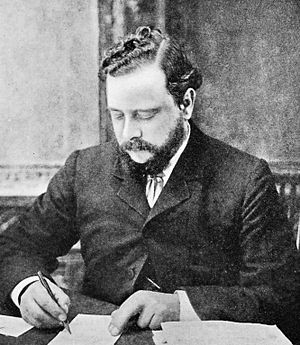Charles Romley Alder Wright facts for kids
Quick facts for kids
Charles Romley Alder Wright
|
|
|---|---|

C. R. Alder Wright, c. 1875
|
|
| Born | 7 September 1844 |
| Died | 25 June 1894 (aged 49) |
| Nationality | English |
| Known for | ... synthesis, aluminium antimonide |
| Scientific career | |
| Institutions | St Mary's Hospital (London) |
Charles Romley Alder Wright (born September 7, 1844 – died June 25, 1894) was an English scientist. He taught chemistry and physics at St Mary's Hospital Medical School in London, England. He was also one of the people who helped start the Royal Institute of Chemistry. Wright made many discoveries, including a special material called aluminium antimonide. He even wrote a book for young readers called The Threshold of Science, which had fun and simple experiments.
Contents
Who Was Charles Alder Wright?
Charles Romley Alder Wright was born in Southend, Essex, England, on September 7, 1844. His parents were Romley Wright and Elizabeth Alder. From a young age, he had a painful hip condition that made him limp. His father, who was a civil engineer, taught him at home when he was young.
Wright went to Owens College, Manchester from 1861 to 1865. He earned his first science degree (BSc) in 1865. While he was a student, he worked with a famous chemist named Henry Roscoe. They did early research on a metal called vanadium. Wright's very first paper was about how light affects photographic paper. It was published in 1866.
After college, Wright worked for a soap and alkali company for about a year. Then he moved to London. There, he worked with other important scientists. He earned his advanced science degree (DSc) in 1870.
Becoming a Lecturer and Founder
In 1871, Wright became a lecturer. He taught chemistry and physics at St Mary's Hospital Medical School in London. He was also a very important founding member of the Royal Institute of Chemistry of Great Britain and Ireland. He was the first treasurer for this institute from 1877 to 1884. He played a big part in setting it up.
In 1881, Wright was chosen as a Fellow of the Royal Society (FRS). This is a very high honor for scientists in England. He also worked as an examiner for different universities and colleges. In 1893, a college in Philadelphia, USA, made him a special member.
Charles Alder Wright passed away on June 25, 1894, when he was 49 years old. He died from health problems. People remembered him as a very dedicated and thorough scientist.
What Did Charles Alder Wright Discover?
Wright was very good at many things. He first thought about becoming an engineer. This helped him make many different discoveries in the field of chemistry.
Discovering Aluminium Antimonide
In 1892, Wright was the first person to find a special material called AlSb, or aluminium antimonide. This material is now known as a compound semiconductor. It can be used in tiny electronics that work very fast and use little power. It can also help detect gamma radiation.
Other Important Work
Besides his work in organic chemistry, Wright also published research on many other topics. These included soap, special papers for photos and waterproofing, and materials for insulation. He also studied metallurgy (how metals are made and used), iron smelting, and different types of metal mixtures called ternary alloys. He even researched chemical dynamics, which is about how chemical reactions happen.

